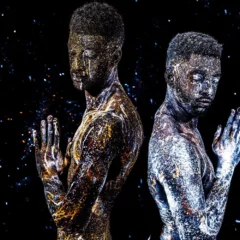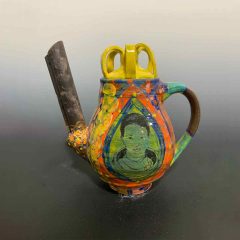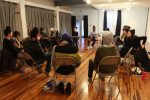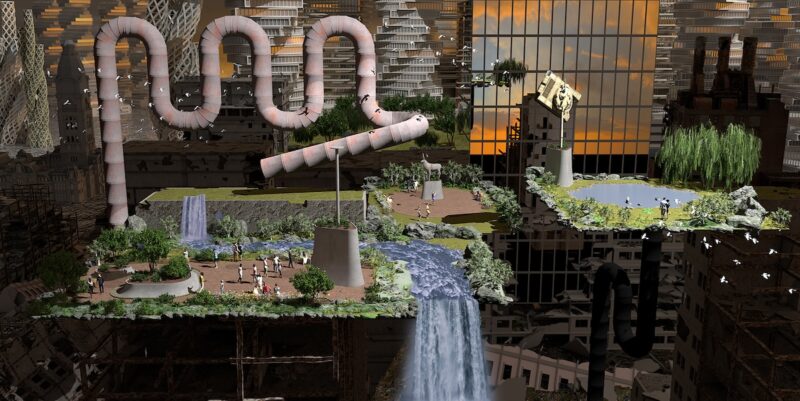
Artists envision large-scale social change in two recent exhibitions in University City – Futures Without Guns and Risky Beauty: Aesthetics and Climate Change. Mounted in non-gallery spaces, the ambitious group-shows interrupt the daily flow of business-as-usual, asking us to consider harsh realities and inconvenient truths.
RISKY BEAUTY: AESTHETICS AND CLIMATE CHANGE
Split between two floors of the Annenberg School for Communication at the University of Pennsylvania, Risky Beauty features work by seven artists overtly addressing the climate crisis. Tucked in between lecture halls and libraries, you can find Hiro Sakaguchi’s vibrant painting of a dynamic world in chaos and Amy Potsic’s quietly lush photographs from her Girl in the Garden series. Both artists employ fictive– and magical–elements to evoke the wonder of nature on the brink. Turn a different corner and you’ll encounter Chantal Westby’s spiraling, apocalyptic sculpture, “Point of No Return.” The piece revolves around a prone figure interwoven with ‘eco slogans’, good intentions either paving the way downwards to a hell that man has wrought or upwards towards a less bleak future, depending on vantage.

Deidre Murphy’s “Oculus Minor” – a suite of six acrylic paintings – shows her layered research into biological patterns; these colorful and coded compilations were inspired by her BioArt Residency with Integral Molecular. Patterns of viral cell migration are overlaid with bird flight patterns affected by light pollution–the repeated round shape referencing microscope and telescope, zooming in and out of the spread of disruption. Hung opposite Diane Burko’s epic mixed media painting “Secret Airstrips,” the circular work invites conversation, in varying volumes, about humankind disastrous effect on the natural world. Maureen Drdak’s “Inferno,” a copper-infused tondo painting, completes the cycle of earth’s downward ecological spiral. The exhibition, curated by Dr. Cynthia Haveson Veloric, has spread its message across several venues before traveling to West Philly, where it was mounted at Annenberg to coincide with an annual convention of environmental journalists. In this recent iteration, Tim Portlock presents a distressed landscape diptych; his computer-generated, three dimensional images render scenes of urban upheaval, bathed in golden light.
FUTURES WITHOUT GUNS
For the exhibit Futures Without Guns (located in an open gathering space at the uCity Science Center, just blocks from the Annenberg School,) Portlock recently unveiled his newest project “Time After the Hunter.” Printed on a massive scale and installed directly on the wall, the work marks a major departure for the artist. Humans appear on the scene. No longer evidenced solely by the wake of their destruction, figures emerge in the post-apocalyptic setting as bearers of hope.
Portlock’s piece – along with the work from eight additional artists – was commissioned specifically for this Pew-funded exhibition, which curator Angela McQuillan,https://angelamcquillan.com/ calls “a bold refusal to accept the normalization of gun violence in our city and in our nation.” The new projects were developed in conversation with Philadelphians with lived experiences of gun violence; the works offer alternatives, through speculative fiction, reimagined spaces, community healing, and legislative change. The scale of the artists’ response is commensurate to the crisis; they went big. Over the course of this collaborative process, Wi Moto Nyota https://www.wi-motonyoka.com/ conceived, wrote, scored and recorded an EP. A Funeral for The Death Machines is an emotive, yet danceable narrative about a gun and a bullet on their final night together.
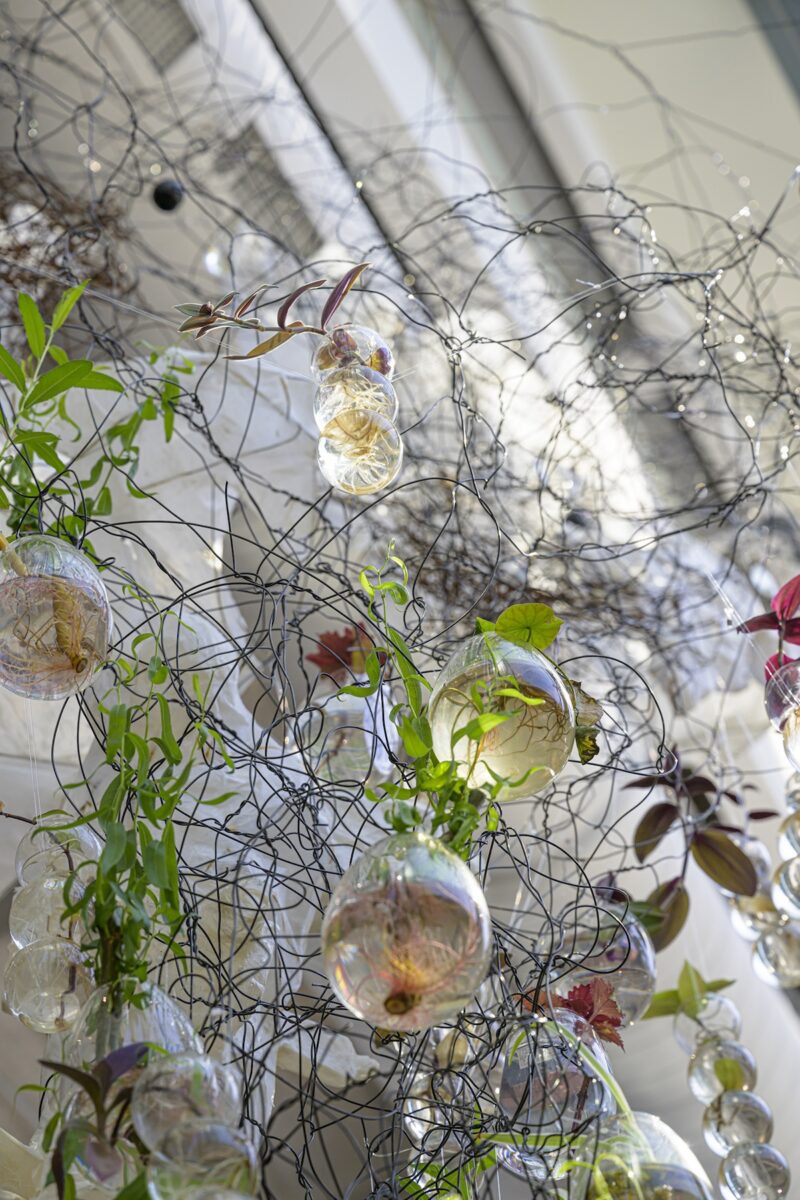
Jasmine Murrell created “Remembering Portal,” a refractive and enchanting hanging glass garden of organic forms that weaves together themes of ancestral wisdom and sacred light. Using natural materials like avocado skins and willow shoots, the artist offers a living path to collective healing. The color green plays a poignant role in Lynn Hershman Leeson’s short film, No Words, depicting a young girl getting ready for school; her brightly colored sneakers a reminder of the Uvalde shooting. Displayed in a nearby vitrine, the small neon shoes are both a warning and reminder.
Artists and organizers, Oluwafemi and Rachael Reyes Vazquez look towards children as the Future without Guns, Vazquez through her direct collaboration with area youth affected by the trauma of gun violence and Oluwafemi through his reimagined playground and comics. Natalie Hijinx’s textural sculpture evokes a surprising dystopian narrative, in which artificial intelligence saves us from our plague of weapons. Technology is a portal to greater empathy in Heather Dewey-Hagborg’s “No Seconds.” Her multi-channel installation surrounds us with the four walls of a jail-cell, its imagery and audio created in collaboration with Amos Joseph Wells III, a convicted felon currently on death row in Texas. In imagining a future without guns, they envision a nation that has abolished the death penalty, this project serving as a memorial to a collective inhumanity.
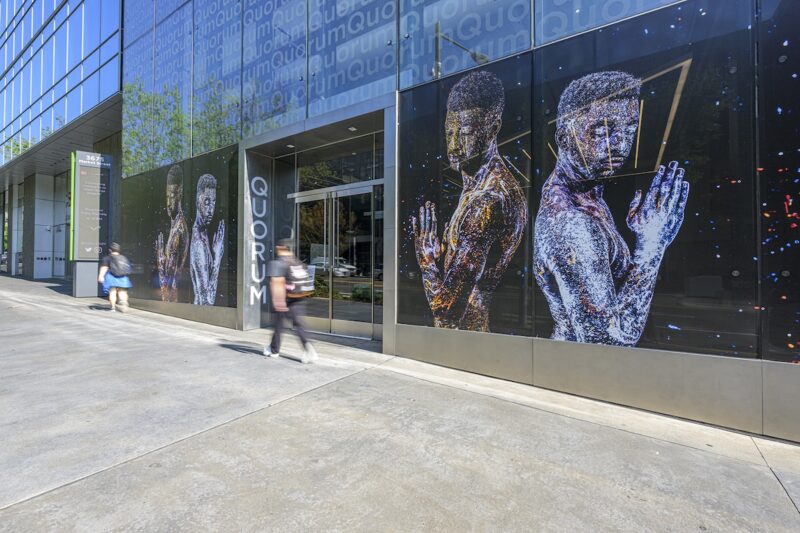
Spanning across the front windows of the Science Center, Mikael Owunna’s photomural “Prayers Answered” beckons viewers inside, the stillness of its larger-than-life ethereal figures in sharp contrast to the traffic of the sidewalk.
Futures without Guns is an impactful exhibition, somehow hiding in plain sight. Risky Aesthetics may not have attracted art-viewing foot traffic but it was aligned with the Environmental Journalists Annual Conference in early April. When pondering these two excellent exhibitions outside of the gallery confines, it is clear that artists can create work that affects change. The question that remains is who will notice and take action?
Risky Beauty: Aesthetics and Climate Change ran April 1 – May 22, 2024
Futures without Guns runs through June 21, 2024
Cindy Stockton Moore is a Philadelphia-based artist who works with aqueous media to create multimedia animations, works on paper, and site-specific installations. Her writing on art has appeared in FlashArt, ArtNews, NYArts Magazine, SciArt Magazine, The New York Sun, Past Present Projects and Title Magazine in addition to university and web publications.
Transparency Notes:
Cindy has previously written about Deidre Murphy + Heather Dewey Hagborg for the Science Center; has collaborated with Angela McQuillan on a number of projects, serving as editor for the Futures without Guns catalog. She has worked with additional artists in these exhibitions–Tim Portlock and WiMoto Nyoka–through her involvement with alternative art collectives + funding.
Read Roberta’s 2022 interview with Cindy Stockton Moore about her studio practice .



